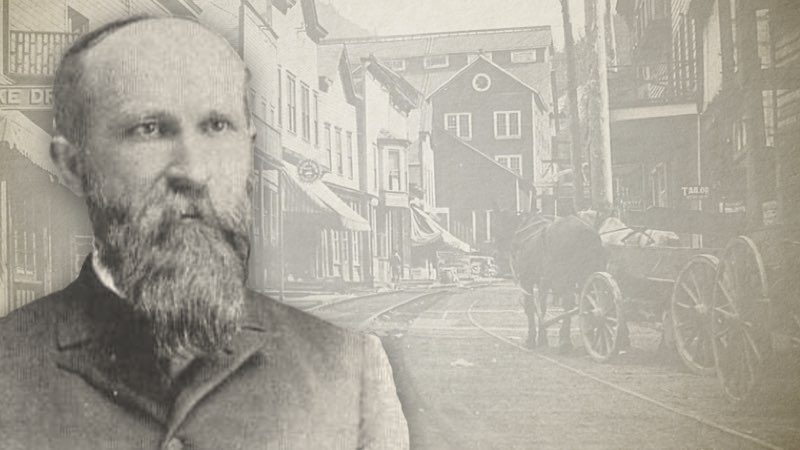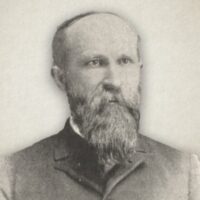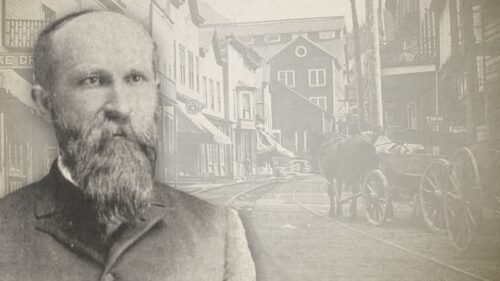
Chapter 13: Heresies and Persecutions
From A.D. 426 to 1500.
Very early in the history of Christianity, as has already been observed, heresies of different kinds commenced to creep into the churches. The true churches being independent of each other, in their organization and government, were but little affected by these heresies. Some of the churches, however, soon lost their independent form, and several combining together formed synods. A number of churches formed a single diocese and were under the control of one bishop. When these churches forming a single diocese became corrupted by false doctrine, or when the bishop begun to preach heretical doctrines, the whole diocese became corrupt. In this way came about the centralization of power which finally resulted in the establishment of popery.
A.D. 416. Just as soon as the Catholics obtained sufficient influence and power, they commenced enforcing baptism, first by curses, and afterwards by might. In the Council at Carthage, in the year 416, the Catholics passed the following edict: “We will that whosoever denies that little children, by baptism are freed from perdition and eternally saved, that they be accursed.” This curse was not simply intended for those who refused baptism to their children, but was pronounced against all who denied, or refused to believe, that children were saved by baptism.
A.D. 565. The Catholics were not long in taking another step in the same direction. State and church were combined and what the church decreed the emperor enforced. Emperor Justinian reigned from A.D. 527 to 565. During his reign he passed an edict declaring, “That such parents as were yet unbaptized should present themselves, with their wives and children, and all that appertained to them in the church; and there they should cause their little ones immediately to be baptized, and the rest as soon as they wore taught the Scriptures according to the canons.”
A.D. 604. Boniface III., was the first pope who assumed universal power, and the first pope in succession. Gregory, the Great, who was the predecessor of Boniface, had declared that “who-soever adopts, or affects, the title of Universal Bishop, has the pride and character of Antichrist, and is in some manner his forerunner.” Gregory died in A.D. 604, and was succeeded by Boniface III., who had no scruples about accepting the title, but rather importunately begged it from the emperor, Phocas, with the privilege also of transmitting it to all his successors. The Church of Rome was at the same time declared, by the emperor, to be the head of all other churches.
On the death of Pepin, king of France, in the year 768, his dominions were divided between his two sons, Charles and Carloman. The latter died two years later, and Charles became sole monarch of that country. Charles, or Charlemagne, as he is usually called, conceived the idea of subduing the Saxons, and forcing them to embrace Christianity. Mr. Orchard says of Charlemagne: ”He resolved on subduing the Saxons, who were pagans, and inhabited a great part of Germany, but this he found impracticable. In the end his imperial majesty proposed to the whole nation the dreadful alternative, either of being assassinated by the troops, or of accepting life on condition of professing themselves Christians by being baptized. They were obliged, on pain of death, to be baptized themselves, and of heavy fines to baptize their children within the year of their birth.”
This was in the year 789. The penalties for neglecting to have their children baptized were as follows: A nobleman was fined 120 shillings; a gentleman 60 shillings; other persons 30 shillings. These were heavy fines, for the price of a good sheep at that time, says Mr. Cramp, was one shilling. Only think of having to pay the price of one hundred and twenty sheep for neglecting, or refusing, to have an infant baptized within one year of its birth! Baptists have always contended for freedom, of conscience.
The first record we have of pouring as having been administered for baptism, if we except the case of Novatian, was in the year 754. Mr. Orchard, quoting a French historian, Mezeray, says: ”Baptism remained in the Catholic church the same and was performed by dipping or plunging, not by throwing or sprinkling. Stephen, the pontiff in 754, gave his opinion that if children were sickly, pouring should in such cases, of necessity, be valid baptism; but ordinarily it was administered by three dippings.” It will be observed that pouring was administered for baptism only in “cases of necessity,” the Catholics deeming baptism necessary to salvation. This is the first instance where the pope claimed the right to change an ordinance.
Immersion continued to be practiced in the administration of baptism, only in exceptional cases even by the Catholics, until the year 1311, when in their council at Ravenna, they allowed a free choice for the first time between immersion, sprinkling or pouring for baptism. It is proper to state that the Catholics do not defend the practice of sprinkling and pouring for baptism from the Scriptures, but wholly on the ground that they have a right to change the ordinances; that the church is above the Bible in authority.
When Constantino, the Great, embraced Christianity, and took it under his protective power, he blended it with the idolatrous worship of pagans, tinder him, and by his direction, the Catholic churches were filled with costly pictures and images. These soon came to be worshipped instead of the true God. About the beginning of the eighth century Leo, the Greek emperor, who reigned at Constantinople, openly opposed the worship of images. The pope replied to him and said: “The eyes of the nations are fixed on our humility and they revere as a God upon earth, the apostle, Saint Peter, whose image you threaten to destroy.”
A.D. 713. As early as 713, the practice of praying for the intercession of saints was common. The pope said it was not the image which they worshipped, but it made them remember the persons whose names they bore. “If,” said he, “it be the image of Jesus, we say, Lord help us. If it be the image of his mother, we say, Pray to your Son to help us. If it be a martyr, we say, St. Stephen, pray for us.”
A.D. 610. Before this time, or as early as 610, the Catholics had what they termed the Feasts of the Ass and Fools, which it is necessary to mention in order to show how they had rendered everything in religion ridiculous and extravagant, and how nearly they were allied with the heathens in their manner of worship. Mr. Jones says: “In several churches of France, a festival was celebrated in commemoration of the Virgin Mary’s flight into Egypt. It was called the Feast of the Ass. A young girl, richly dressed, with a child in her arms, was placed upon an ass superbly decorated with trappings. The ass was led to the altar in solemn procession—high mass was said with great pomp—the ass was taught to kneel at proper places—a hymn, no less childish than impious, was sung in his praise; and when the ceremony was ended, the priest, instead of the usual words with which he dismissed the people, brayed three times like an ass; and the people, instead of the usual response, brayed three times in return. The festivals of Fools and Asses were established in most churches. On days of solemnity, they created a bishop of fools; and an ass was led into the body of the church, dressed in a cape and a four-cornered cap. Church dances, feastings on the altar, revelry and obscene farces were the ceremonies observed on those festivals, and in many dioceses these extravagancies were continued for seven centuries.” The people were taught at that time, as they now are by the Catholics, that it was not lawful for them to read the Bible, but for priests only, and if we are to judge by the teachings and conduct of the priests, we must conclude that they read it no more than did the people. One class was as corrupt as the other.
A.D. 780. About the year 780, the doctrine of transubstantiation begun to prevail. This means that the bread and wine in the Lord’s Supper is transformed, or changed, into the actual body and blood of Christ. The Catholics taught, and do now, that the partaking of the Lord’s Supper was essential to salvation, thus attaching to it a saving efficacy. Hence they called it the sacrament of the Lord’s Supper. This false idea gave rise to its abuses, and it was taken to the sick chamber and administered to the dying. It was then given to infants in the belief that it was essential to their salvation. In commenting upon the passage, “Except ye eat the flesh of the Son of man, and drink his blood ye have no life in you,” Augustine said, “And dare any one be so bold as to say, that this sentence does not appertain to little children, or that they can have life without partaking of this body and this blood.”
This practice of giving the Lord’s Supper to infants continued in the Catholic church for many centuries, says Hinton, until the Council of Trent abrogated the practice. That the custom of giving the Lord’s Supper applied to real infants is seen from the following: “In Gregory’s Sacramentarum, there is an order ‘that infants be allowed to suck the breast before the holy communion, if necessity so required.” Mr. Hinton assigns as a reason why infant communion was abandoned that “the babes would sometimes spit out the sop (for the bread was sopped in the wine) to the great consternation of believers in transubstantiation. To obviate this the bread was taken away from the infant, and the priest dipped his finger in the cup and put it in the babe’s mouth, (as is the practice in the Greek church to this day). But when the cup came to be taken from the laity, in the Kornish church, then the babes were deprived of the Lord’s Supper.”
Towards the end of the eighth century the doctrine of the Paulicians became very widely disseminated throughout the East, and towards the middle of the ninth they had become so numerous, that extreme measures were resorted to for their suppression. The influence of the Greek empress Theodora, was engaged for the accomplishment of this end. In the year 845, “Her decrees were severe, but the cruelty with which they were put into execution by her officers were horrible beyond expression. Mountains and hills were covered with inhabitants. Her sanguinary inquisitors explored cities and mountains in Lesser Asia. After confiscating the goods and property of one hundred thousand of these people, the owners to that number were put to death in the most barbarous manner, and made to expire slowly under a variety of the most exquisite tortures.”
A.D. 850. About the middle of the ninth century a schism occurred in the Catholic church, growing more out of jealousy and ambition than other causes. This breach was apparently healed in 869, but broke out again later and finally culminated in a final separation, which gave rise to the two churches known as the Greek Catholic church and the Roman Catholic church. The Greek church is known in history as the Eastern church, while the Roman is known by the names Latin or Western church. Dr. Ford says: “The contests and rivalries between these two divisions of an apostate, monarchical church, continued till their final separation, July, A.D. 1054, when after [A.D. 1054.] the pope of Constantinople had excommunicated the pope of Rome and his adherents, the pope of Rome excommunicated him and his, and from that date the Roman Catholic church was born, and was a sect distinct from the Greek Catholic church.”
The Greek church still administers baptism by immersing the subject three times in water. This is what is known as trine immersion. Such was also the practice of the Roman Catholic church at the time the division occurred, and continued to be for several centuries later. The Greeks practice infant baptism, but administer it as they do to adults, by trine immersion. This organization is very strong in the East, and have very recently paid their respects to the Baptists by declaring in one of their synods their purpose to persecute them in Southern Russia.
The Greek clergy had the character in the tenth century, as having been as corrupt as the Romish. With regard to the corruption of the Romish clergy at this time the learned Mosheim says: “It is a history of so many monsters, and not of men; and exhibits a horrible series of the most flagitious, tremendous, and complicated crimes, as all writers, even those of the Romish communion unanimously confess.”
Orchard says of the same: “The clergy were not only ignorant, but they were adulterers and sodomites; and so avaricious as to sell anything for money. Their illegitimate children were provided for out of the revenues of the church; but they could not be supported without proving their connexion and membership, which was established by baptism. This urgency pushed forward baptism from minors to infants.”
The church of Rome had already declared itself to be the head of all other churches. The bishops now sought to bring the whole of Europe into subjection to their will, and to take from its people—from the emperor to the poorest subject— every vestige of civil and religious liberty. Mr. Jones says: “About the year 877, Pope John VIII convened a council at Troyes, in Franco, one of the canons of which is sufficiently remarkable to be adduced as a specimen of the spirit of the times. It expressly asserts that ‘the powers of the world shall not dare to seat themselves in the presence of the bishops unless desired.'” The pope of Rome was now more powerful than the emperor.
A little earlier than this, or in the year 822, the pope of Rome became disaffected towards the emperor. He encouraged the emperor’s sons in a rebellion against their father. Gregory IV, being at that time pope of Rome, went to France, in the army of Lothaire, the eldest son, and succeeded in deposing the emperor. Mr. Jones says: “He was deposed in a tremendous assembly, and Lothaire proclaimed in his stead; after which infamous transaction, the pope returned to Rome.”
Gregory VIII came to the pontifical chair in the year 1073. Each succeeding pope seemed to have increased in power over his predecessor, and this Gregory appears to have reached the climax, for there was no limit to his ambition. Indeed he held the sceptre of a monarch, and kings and emperors were alike subject to his will. He engaged the Catholic church in open war with all the sovereigns of Europe, and especially Henry IV., of Germany, and endeavored to render them tributary to his will. Becoming displeased with the conduct of Henry, the pope convened a council in the presence of which he made this declaration: “In the name of Almighty God, and by your authority,” said Gregory, addressing the members of the council, “I prohibit Henry from governing the Teutonic kingdom and Italy. I release all Christians from their oath of allegiance to him; and I strictly forbid all persons to serve or attend him as king.”
In a letter to Solomon, king of Hungary, this same Gregory wrote: “You ought to know, that the kingdom of Hungary belongs to the Roman church; and learn, that you will incur the indignation of the holy see, if you do not acknowledge that you hold your dominions of the pope and not of the emperor.”
This presumptuous declaration, and the neglect with which it was treated, says Mr. Jones, brought the quarrel between the empire and the church to a crisis: it was directed to Solomon, but intended for Henry.
Smarting under the indignity which had been inflicted upon him by the pope, and feeling that his power had been shorn from him, the emperor of Germany determined to cast himself at the feet of the pope, and seek the restoration of his favor. Mr. Jones gives us the following account of the interview: “To avoid the odium of the impending trial, Henry took the strange resolution of suddenly passing the Alps, accompanied only by a few domestics, and of throwing himself at the feet of Gregory, in order to implore his absolution. The pontiff was at that time on a visit to the Countess or Duchess Matilda, at Canosa, a fortress on the Appenines. At the gate of this mansion the emperor presented himself, as an humble penitent. He also was admitted within the outer court, where being stripped of his robes, and wrapped in sack cloth, he was compelled to remain three days in the month of January (A.D. 1077), barefoot and fasting, before he was permitted to kiss the feet of his holiness! The indulgence was, however, at length granted him—he was permitted to throw himself at the feet of the haughty pontiff, who condescended to grant him absolution, after he had sworn obedience to the pope in all things, and promised to submit to his solemn decision at Augsburg; so that Henry reaped nothing but disgrace and mortification from his journey, while the pontiff, elate with triumph, and now considering himself as lord and master of all the crowned heads in Christendom, said in several of his letters, that it was his duty to pull down the pride of kings.”
Such were the indignities of the Roman Catholic church, “Mother of the Faithful!”
Author of the “Compendium Of Baptist History”. Please inform the Editor of the AHB (via the Contact page) if you have biographical information on this author. Thank you.
Shackelford on Baptist History (Complete)




